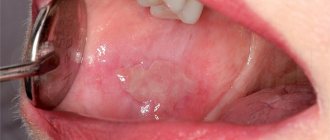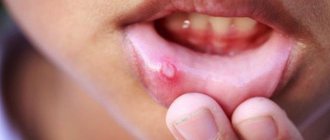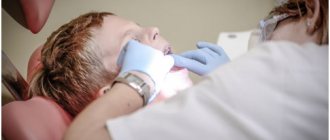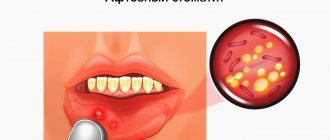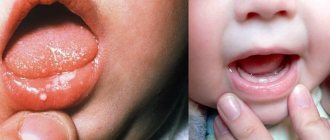Causes of mononucleosis
Mononucleosis is caused by a type of herpes virus (Epstein-Barr virus). The route of transmission of infection is airborne droplets.
. The disease does not pose an epidemic threat. The virus quickly dies in the external environment. But it is present in saliva. A child who puts various objects into his mouth can become infected, especially if he is in a group of children in which there is a carrier of the infection. Therefore, outbreaks of mononucleosis sometimes occur in kindergartens.
Family foci of the disease are also recorded. Emphasizing this feature, mononucleosis is called the “kissing disease.” Most often it affects children aged from one to 10 years. The second peak in incidence occurs in adolescence. By the time they reach adulthood, most people are immune to mononucleosis.
Symptoms of mononucleosis
The incubation period of mononucleosis is on average 7-10 days, the maximum duration is 21 days.
Most often, the disease begins acutely, with a rise in temperature. If the temperature does not rise immediately, it usually occurs towards the end of the first week of illness. During the course of illness, the temperature may rise several times. It decreases gradually. In the evening, a slight increase in temperature may be observed for quite a long time. In some cases, no increase in temperature is observed.
Other symptoms may also be present in both pronounced and vague forms.
The acute period of the disease usually lasts 2-3 weeks. The recovery process can take quite a long time (up to several months). Swelling of the lymph nodes and a slight increase in the size of the liver and spleen persist the longest.
The main symptoms of mononucleosis:
Temperature increase
Mononucleosis is characterized by an increase in temperature to 38°C and above. A rise in temperature is accompanied by chills, body aches, and headache.
Enlarged lymph nodes
First of all, swelling of the cervical lymph nodes is detected. Sometimes axillary, inguinal and other groups of nodes increase.
Redness of the tonsils
There is redness and enlargement of the palatine tonsils. Quite often the whole complex of symptoms of angina appears.
Stuffy nose
The nose is stuffy, but there is no discharge from the nasal passages (no runny nose).
More about the symptom
Enlarged liver and spleen
With mononucleosis, an increase in the size of the liver and spleen is observed (reaches a maximum on the 4th – 10th day, but can manifest itself from the first days of the disease).
Rash
Various types of rashes may appear. The rash disappears after a few days, leaving no traces.
More about the symptom
Content:
- The danger of herpetic stomatitis
- Causes of the disease
- Manifestation of herpetic stomatitis
- Diagnosis of the disease
- Treatment of herpetic stomatitis
The danger of herpetic stomatitis
Herpetic stomatitis is an inflammatory disease of the oral mucosa, which is caused by a well-known infectious agent - the herpes virus. Simple forms of inflammation cause discomfort, but do not threaten the patient. However, there are situations when the disease becomes severe: in addition to pronounced ulcerative-necrotic inflammation of the oral epithelium, the respiratory tract, vascular wall, and even internal organs can be involved in the process. You need to know the manifestations of this disease in order to consult a specialist in time, carry out treatment, prevent repeated episodes of herpetic stomatitis (since infection with the herpes virus is accompanied by its lifelong presence in the body) and prevent possible complications.
Causes of the disease
The etiological factor causing stomatitis in this case is herpes simplex virus type 1. There are also HSV - type 2, the so-called “genital herpes”. It is transmitted only sexually and causes damage to the mucous membranes of the genital organs; in this case, there is no herpetic lesion of the oral cavity. The mechanism of transmission of herpes simplex virus type 1 is carried out mainly by contact, much less often by aerosol. Infection occurs at an early age. The first episode of stomatitis is most often observed in childhood. This is primarily due to the fact that by the first year of life the child’s immune protection received from the mother weakens. Childhood is the main risk factor for developing the disease. In some cases, infection is not accompanied by any symptoms, and the child becomes a carrier of the virus. In this case, the disease can manifest itself at any age. For the development of the disease, predisposing factors are also necessary: a decrease in the body's defenses - hypothermia, stressful situations, hormonal disorders, exacerbation of chronic diseases. The herpes virus refers to microorganisms that have tropism (the ability to interact with certain tissues) for epithelium and nervous tissue. In this regard, the lesions will be localized on the mucous membranes and in the nerve formations of the body. Penetrating into cells, the virus begins to multiply and eventually spread throughout the body. Depending on the magnitude of the viral load, the disease will manifest itself at the time of infection or only after sufficient accumulation and reactivation.
Manifestation of herpetic stomatitis
Herpetic stomatitis as one of the forms of the disease occurs more often than others. The clinical picture is specific and allows, in most cases, to promptly recognize the disease and begin treatment. From the onset of symptoms to complete recovery, it can take from 3-5 days to several weeks. Most often, stomatitis begins with an increase in temperature to subfebrile levels. There may be mild symptoms of ARVI - redness of the mucous membrane of the nose, pharynx, tonsils. Lymph nodes can be involved in the process if the body overreacts to the introduction of the virus - most often this happens during the first episode of herpetic stomatitis. Lymph nodes in the head and neck area enlarge and become painful on palpation. The main morphological element of herpetic inflammation is the vesicle (vesicle). A vesicle appears on an inflamed reddish area of the mucous membrane of the lips, gums, cheeks or other area; it can be represented by a single element or multiple vesicles. During its development, the blister gradually increases (on average 2 mm, maybe up to 5 mm), bursts, and in its place an ulcer - aphthae - forms. Herpetic elements in the oral cavity and any other location are very painful. Sometimes there is severe salivation. In the case of moderate and severe cases, other organs are also involved, body temperature rises to 39-40 degrees, signs of intoxication are expressed - myalgia, arthralgia, nausea, vomiting, diarrhea, severe weakness. A lot of vesicles appear; after rupture, they turn into deep ulcers and become necrotic.
Diagnosis of the disease
If you suspect a herpetic lesion of the oral mucosa, you should consult a dentist. In some cases, a consultation with a general practitioner and a dermatovenerologist may be indicated.
Diagnosis is not difficult: collection of complaints and examination makes it possible to make a correct diagnosis at an early stage. In diagnostically unclear cases, methods of special diagnosis of the pathogen may be prescribed - it is detected in scrapings from the mucous membrane (virological diagnosis is difficult), an increase in the titer of antibodies in the blood (a more effective method), PCR diagnostics, and others.
Treatment of herpetic stomatitis
Treatment can be symptomatic - treatment of the oral cavity with solutions: hydrogen peroxide 3%, potassium permanganate 1:10000, furatsilin; it is possible to prescribe painkillers. Etiological treatment is prescribed when the diagnosis of herpes is confirmed. Specific antiviral drugs are used that act on the pathogen - Acyclovir, Valciclovir, Famciclovir. There are forms for local treatment in the form of ointments, as well as tablet and soluble preparations. In simple forms, antiviral drugs are applied only to the affected areas.
Methods for diagnosing mononucleosis
Symptoms of mononucleosis are not specific. Therefore, diagnosis is based primarily on laboratory data. The necessary studies are combined in the profile “Diagnostics of infectious mononucleosis”.
General blood analysis
A complete blood count for mononucleosis usually shows an increase in the number of leukocytes and ESR. Characterized by a significant increase in lymphocytes and monocytes, together these varieties can account for up to 80-90% of the total number of leukocytes. The main symptom of mononucleosis is an increase in the number of specific cells - atypical mononuclear cells (which are altered lymphocytes) to a level of over 10%. However, they are detected no earlier than on the 5th day from the onset of the disease.
More information about the diagnostic method
Blood chemistry
Mononucleosis can manifest itself in the results of a biochemical blood test in the form of a two- or three-fold increase in the activity of ALT and AST. When the skin turns yellow (jaundice), bilirubin increases.
More information about the diagnostic method
Serological blood test
Using serological analysis, specific antibodies to the causative agent of mononucleosis, the Epstein-Barr virus, can be detected.
More information about the diagnostic method
Sign up for diagnostics To accurately diagnose the disease, make an appointment with specialists from the Family Doctor network.
Types of disease
- Bacterial stomatitis. It is diagnosed when the oral cavity is damaged by microorganisms, most often streptococci and staphylococci.
- Herpetic stomatitis. The causative agent is the herpes virus. Small blisters form in the oral cavity, which, after opening on their own, transform into painful ulcers.
- Aphthous stomatitis. It can be a complication of ENT diseases or occur against the background of decreased immunity. It is characterized by the formation of aphthous erosive areas in the mouth.
- Candidal stomatitis. A disease caused by fungi of the genus Candida. The characteristic symptoms include a cheesy coating on the tongue, lips, and cheeks.
- Ulcerative stomatitis. It usually occurs with extensive inflammation of the mucous membrane and the formation of painful ulcers on its surface.
- Allergic stomatitis. The main reason is an allergic reaction of the mucous membrane to food, pollen and other allergens. The disease is one of the symptoms of allergies.
Rarer types of stomatitis are also known - radiation (a consequence of radiation sickness) and chemical (a consequence of acid burns).
Treatment methods for mononucleosis
Treatment of mononucleosis in children is carried out by a pediatrician. In acute cases of the disease, you should call a doctor at home.
There are no specific treatments for mononucleosis. Antiviral drugs, corticosteroids and immunomodulators are prescribed only for severe cases of the disease. Antibiotics are used in case of bacterial infection.
Treatment of mononucleosis is carried out according to a scheme common to many acute respiratory viral infections.
Drink plenty of fluids
To reduce intoxication of the body, you need plenty of warm drink.
Symptomatic treatment
At temperatures above 38.5°C, antipyretic drugs are used. If symptoms of tonsillitis occur, antiseptics are prescribed. Gargling is recommended.
Diet correction
Since mononucleosis can occur with liver damage, a diet limiting fatty, spicy and fried foods is recommended (table No. 5).
Taking vitamin supplements
For mononucleosis, vitamin therapy (vitamins B, C and P) is indicated.
Make an appointment Do not self-medicate. Contact our specialists who will correctly diagnose and prescribe treatment.
Rate how useful the material was
thank you for rating


